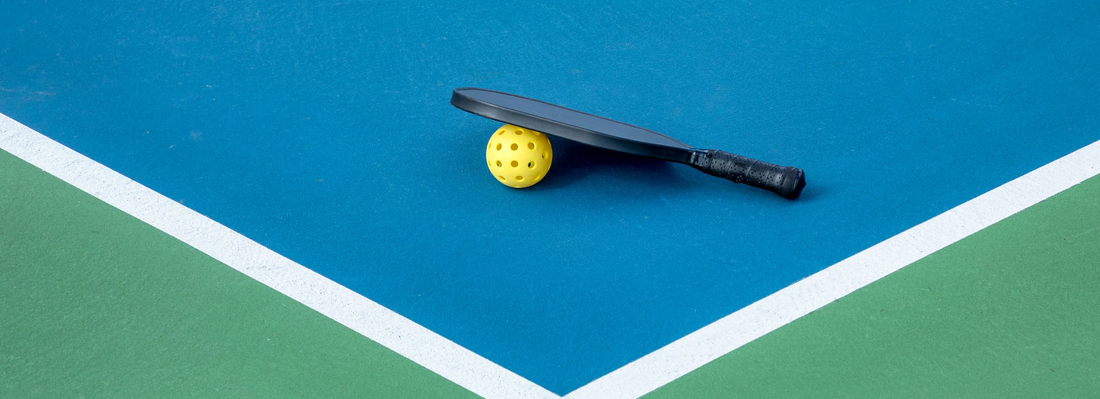
From Court Lines to Paddle Design: How Rules and Dimensions Define the Modern Pickleball Experience
Share
Pickleball is more than a fast-paced rally sport. It is a precise blend of geometry, physics, and creative regulation—a game where inches matter as much as instinct. Every line drawn on the court and every curve sculpted into a paddle contributes to the sport’s unique balance of control, strategy, and inclusivity. Understanding how these details shape the modern pickleball experience reveals why the game has captivated players across all ages and skill levels.
The Foundation of the Court
At first glance, a pickleball court looks deceptively simple—a compact rectangle with a net in the middle. Yet its design is the result of meticulous calculation. Measuring 20 feet wide and 44 feet long, the court is intentionally smaller than a tennis court to encourage rallies, precision, and quick reflexes.
The non-volley zone, or the kitchen, extends 7 feet from the net on each side. This critical boundary prevents players from dominating the game with overhead smashes at the net, fostering strategy over sheer power. The result is a game that rewards balance—between attack and defense, aggression and patience.
Behind the kitchen, the service areas each span 10 feet wide and 15 feet deep, requiring diagonal serves and promoting thoughtful ball placement. The entire setup ensures that both beginners and advanced players must master the art of controlled movement within compact space.
The Precision of the Net
The net’s dimensions might seem trivial, but they influence every rally. At 36 inches high at the sidelines and 34 inches at the center, the subtle dip encourages low, fast shots that skim across the tape. This design forces accuracy and sharp reflexes while keeping rallies dynamic.
Even the tension of the net matters. A loosely hung net deadens shots and alters bounce, while an overly tight one exaggerates deflections. Consistent calibration preserves fairness and maintains the sport’s characteristic rhythm.
Paddle Design and the Evolution of Feel
If the court defines the stage, the paddle defines the player’s voice. Early pickleball paddles were made of plywood—simple, durable, and heavy. Modern designs have evolved into marvels of material science. Carbon fiber, fiberglass, and polymer cores now dominate, each contributing distinct performance traits.
1. Size and Shape Regulations
According to official guidelines, the combined length and width of a pickleball paddle cannot exceed 24 inches, with most standard paddles measuring around 16 inches long and 8 inches wide. These dimensions ensure uniformity while allowing subtle variations that influence playstyle.
Elongated paddles, for example, offer extra reach at the expense of maneuverability, while wider paddles provide a larger sweet spot for consistency. This design balance allows customization without compromising competitive fairness.
2. Core Thickness and Control
Paddle cores typically range from 12mm to 16mm thick, a dimension that directly impacts playability. Thinner cores provide more pop and speed, while thicker cores enhance control and touch. The choice becomes a reflection of the player’s personality—whether they favor fiery drives or patient dinks.
3. Surface Texture and Spin
Regulations also limit how rough a paddle’s surface can be to prevent excessive spin. Manufacturers use microscopic textures and woven carbon patterns to enhance grip on the ball while adhering to standards. The science of spin has turned paddle design into an art form, balancing power with precision.
Rules as the Great Equalizer
Pickleball’s rules, though straightforward, are crafted to keep the game fair and engaging. The two-bounce rule, for instance, requires that the ball bounce once on each side before volleys are allowed. This rule neutralizes aggressive serves and ensures rallies develop strategically rather than devolving into smash fests.
The double scoring system in doubles play—where only the serving team can score—also slows the game’s tempo and emphasizes consistency. Each regulation, while seemingly restrictive, enhances inclusivity, allowing different playstyles to coexist and thrive.
The Design Philosophy Behind Simplicity
What makes pickleball so magnetic is the harmony between design and accessibility. The court’s compact size invites players of all ages. The paddle’s shape encourages finesse rather than brute strength. Even the rules themselves create a rhythm of movement that feels intuitive yet endlessly complex.
It is a sport engineered for joy and longevity. The boundaries, rather than limiting creativity, provide structure for mastery. Within those 20 by 44 feet, players express individuality through angles, timing, and touch.
The Future of Design and Regulation
As pickleball expands globally, both paddle technology and court innovation continue to evolve. Smart paddles embedded with sensors are beginning to track swing speed and impact data, helping players refine their technique. Portable modular courts now allow communities to transform open spaces into playable areas within hours.
However, governing bodies maintain a careful balance between innovation and tradition. Regulations adapt slowly to preserve the spirit of the game while welcoming progress that enhances play without compromising fairness.
Conclusion
Pickleball thrives at the intersection of design and discipline. The precise court layout, the regulated paddle dimensions, and the carefully crafted rules create a framework that balances creativity with equality. From the first serve to the final point, every element—line, net, paddle, and motion—plays its part in shaping a uniquely human experience of focus, fun, and flow.
In the end, it is this blend of structure and spontaneity that makes pickleball not just a sport, but a symphony of balance—where design and rulebook together craft a game that feels endlessly alive.












